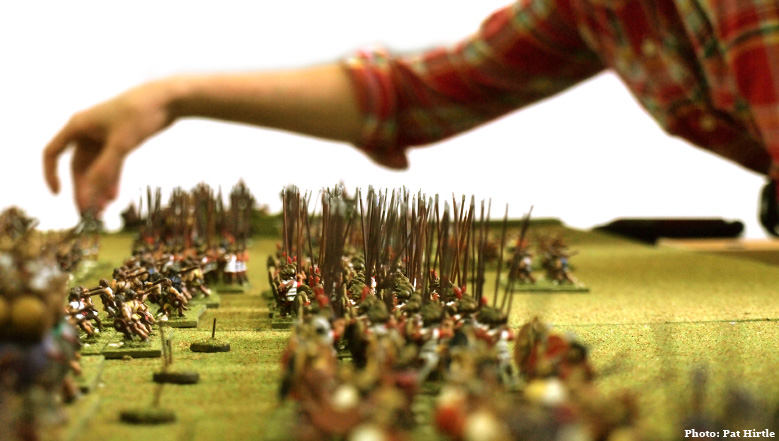Just prior to the end of the year I managed to get some time off to head up to Kobe and Osaka to get together with a couple of wargaming buddies for some face-to-face games.
The first day was spent at Pat's place, where we got through two games of GMT's Manoeuvre and a few more of GMT's Battle Line. I quite enjoyed Manoeuvre even though it's more of a strategy game than a 'battle' game, and I was struck by its similarities to DBA. As in DBA, armies are made up of a set mix of national army lists and battlefields are generated for each game played, these being made up of four 4x4 square sections drawn randomly. Gameplay however is rather different. In Manoeuvre there are four parts to the turn: card draw, movement, battle and rally. Your turn starts by drawing cards to your hand limit of five, with discards allowed. You must then move one unit per turn (whether you want to or not) and a second unit may also be moved on the play of a special card. The combat phase then follows, and this is where things get interesting. You may only attack once per turn and only if you have a card to activate the unit you wish to attack with. If you decide to launch an attack, the process is simple but engaging: play the unit card to initiate the assault and wait to see your opponent's response. He may withdraw if permitted or play a card to augment his own chances in the battle. Supporting units can then be drawn into the combat by the attacker through the play of a leader card and once all cards relating to this combat have been tabled the combat is resolved. This is done by totalling up the combat factors of the units involved, plumping in modifiers for terrain and adding the scores from any extra dice rolls that the cards played may give the participants. The attacker's score is then compared to the defender's and, depending on the ratio between them, a result is found. For example, a four to one sees the defender eliminated; a two to one result sees the defender losing a step or retreating, at the attacker's choice; a result above one to one but less than two to one is a step loss or a retreat at the defender's choice. If the defender wins the combat the attacker simply takes a step loss.
This is a rough outline of the process for assault combat, but there is also volley and bombard combat which can take place at longer ranges and does no injury to the attacker if the attack fails.
After combat is finished the active player may choose to use a card and rally one of his spent units. If the rally is successful then the unit returns to full strength.
These turns proceed until five enemy units are eliminated or both players run through their card decks, at which point the winner is decided by who controls more of the battlefield at day's close.
There are eight armies in the game, each with a slightly different mix of units and cards to activate them (each power uses a national deck of 60 cards) so it has great replayability. It's also pretty simple to pick up but will repay thoughtful play, so it's a winner as far as I'm concerned. One thing about it that I particularly liked is the follow up rule which has a victorious unit following up into a space cleared by a successful attack. This allows for some clever play with traps, gambits and bluffs, allowing a battle of wits to develop over time. If I could convince my wife to play I'd probably pick it up, but I somehow doubt that this will be possible at the moment!
So after a lovely day's play at Pat's it was time to jump on the train to Luke's place for some heavier-duty ancients gaming, but that is a story for another post...

No comments:
Post a Comment